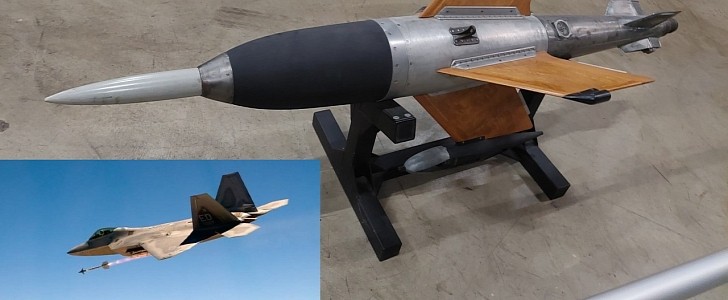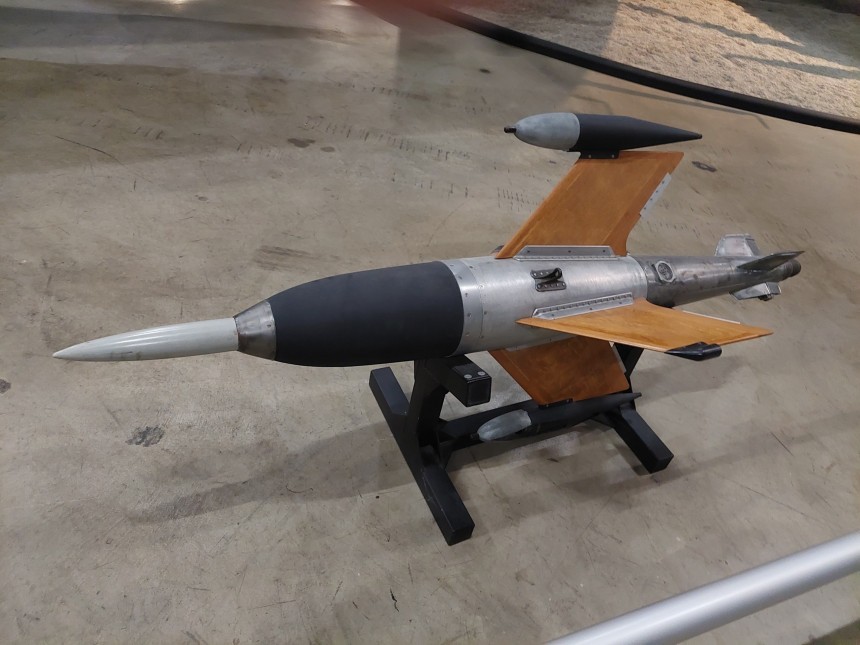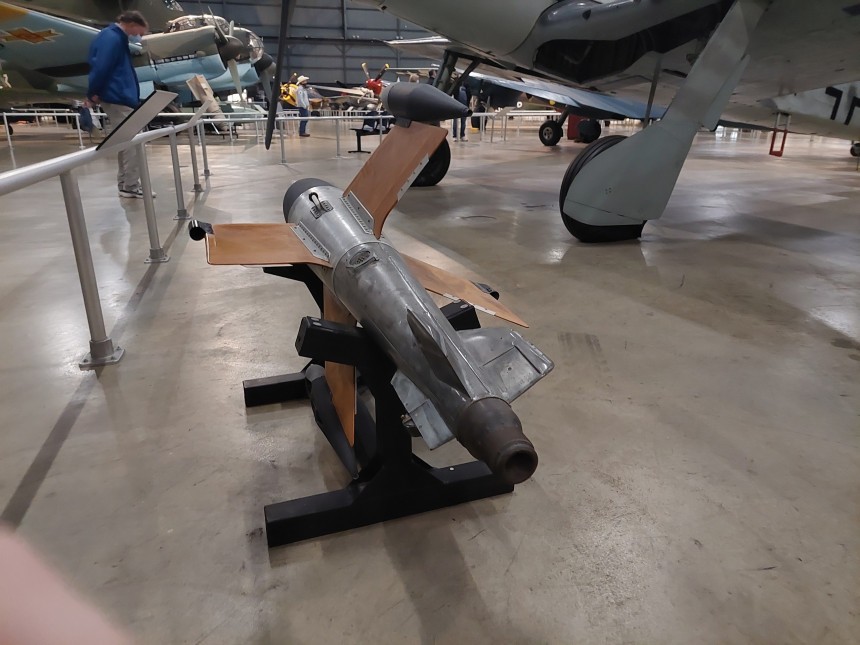We tend to take air-to-air missiles for granted in military fighter jet games like Ace Combat and War Thunder. It doesn't help that you're given an infinite amount of them in their air arcade modes.
Things were much more complicated over the skies of Second World War Germany. A group of top German engineers would lay the foundation for what would become the air-to-air missile during this time and lay the groundwork for all AAMs going forward.
Think of the newest and most advanced air-to-air missile system you can think of. Say, the latest Aim-9X Sidewinder heatseeker or the Aim-120 AAMRAM fire and forget missile. We want you to take its construction back to its most primitive components, and the result will look something like the Ruhrstahl X-4. A weapon as basic as a guided missile could possibly be. It still couldn't save the Luftwaffe from ultimate defeat.
Not that the technology involved couldn't fool someone ignorant of history into thinking it could change the tide of the war. Daylight strategic bombing campaigns wreaked havoc on the German cities in the later stages of the European theater. If something could be created that could one-shot B-17s and B-24s out the sky in large numbers, it could significantly impact the tides of victory.
There were more than a few novel concepts for such an idea. One was to fit an enormous 50mm anti-tank gun into the nose of the Messerschmitt Me-262. But that gun could only hold 21 rounds of ammunition, barely enough to shoot down a couple of bombers out of massive hoards of dozens flying at once. A design was also planned for a rocket interceptor that took off vertically and could fire high explosive rockets out of a retracting nose cone.
All thoroughly awesome weapons if you're a nine-year-old, but nowhere near adequate to stop the onslaught of American, British, Canadian, Australian, and Soviet aircraft pounding deeper towards Berlin with every passing day. But maybe, the German Army thought, the advent of the air to air missile would be the ticket that stopped the Allied daylight bombing campaigns. There was good reason to suspect it would work. The missiles would be attached to German fighter aircraft and were connected to the cockpit via lengths of wire that allowed the missiles to be controlled via a joystick inside the cockpit.
Special sensors within the warhead could detect enemy bomber engines by "tuning in" to the vibrations these powerplants made in flight while closing in at 560 miles per hour (901 kph). Once close enough to the target, the 44 pounds (20kg) warhead would detonate, much the same as a modern air-to-air missile would be today. The major difference was the several miles of wire cables that connected the mothership to the missile's guidance system.
For some modern context, let's compare these numbers to that of a modern air-to-air missile, the Aim-9X Sidewinder. The Sidewinder can travel at up to two and a half times the speed of sound when fired. Its weight is approximately 180 pounds (81.6 kg), including the warhead, compared to 130 pounds (60 kg) in the X-4. The Sidewinder's warhead is actually smaller than that of the X-4. Between nine pounds to 24 depending on the variant. The type relied on the kinetic energy of supersonic flight to compensate for the lack of explosive power and save weight in the process.
It's estimated that over 1,300 Ruhrstahl X-4 missiles were manufactured between 1943 and the end of the European conflict in May 1945. It's possible that many more could have been made had the factory producing them not been destroyed by the very same Allied strategic bombing campaign that the missiles were meant to prevent. Ultimately, the Germans opted not to continue the development of the X-4 and focused their time on more destructive "victory" weapons like the V1 buzz bomb and the V2 ballistic missile. The German Army unconditionally surrendered soon afterward.
Air-to-air missile technology wouldn't catch up to the Germans for at least another decade. The first Aim-9A Sidewinders found their way onto American fighter aircraft in May 1956. They wouldn't become preferable to machine guns and cannons until well into the 1960s and the days of the American war in Vietnam. It's truly frightening to think just how much more advanced the German military was compared to its enemies during the Second World War. We suppose not every conflict can be won with superior technology. Otherwise, we'd probably all be speaking German. Check back for more fun military content right here on autoevolution.
Think of the newest and most advanced air-to-air missile system you can think of. Say, the latest Aim-9X Sidewinder heatseeker or the Aim-120 AAMRAM fire and forget missile. We want you to take its construction back to its most primitive components, and the result will look something like the Ruhrstahl X-4. A weapon as basic as a guided missile could possibly be. It still couldn't save the Luftwaffe from ultimate defeat.
Not that the technology involved couldn't fool someone ignorant of history into thinking it could change the tide of the war. Daylight strategic bombing campaigns wreaked havoc on the German cities in the later stages of the European theater. If something could be created that could one-shot B-17s and B-24s out the sky in large numbers, it could significantly impact the tides of victory.
There were more than a few novel concepts for such an idea. One was to fit an enormous 50mm anti-tank gun into the nose of the Messerschmitt Me-262. But that gun could only hold 21 rounds of ammunition, barely enough to shoot down a couple of bombers out of massive hoards of dozens flying at once. A design was also planned for a rocket interceptor that took off vertically and could fire high explosive rockets out of a retracting nose cone.
Special sensors within the warhead could detect enemy bomber engines by "tuning in" to the vibrations these powerplants made in flight while closing in at 560 miles per hour (901 kph). Once close enough to the target, the 44 pounds (20kg) warhead would detonate, much the same as a modern air-to-air missile would be today. The major difference was the several miles of wire cables that connected the mothership to the missile's guidance system.
For some modern context, let's compare these numbers to that of a modern air-to-air missile, the Aim-9X Sidewinder. The Sidewinder can travel at up to two and a half times the speed of sound when fired. Its weight is approximately 180 pounds (81.6 kg), including the warhead, compared to 130 pounds (60 kg) in the X-4. The Sidewinder's warhead is actually smaller than that of the X-4. Between nine pounds to 24 depending on the variant. The type relied on the kinetic energy of supersonic flight to compensate for the lack of explosive power and save weight in the process.
It's estimated that over 1,300 Ruhrstahl X-4 missiles were manufactured between 1943 and the end of the European conflict in May 1945. It's possible that many more could have been made had the factory producing them not been destroyed by the very same Allied strategic bombing campaign that the missiles were meant to prevent. Ultimately, the Germans opted not to continue the development of the X-4 and focused their time on more destructive "victory" weapons like the V1 buzz bomb and the V2 ballistic missile. The German Army unconditionally surrendered soon afterward.







